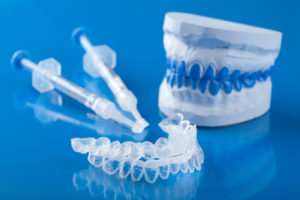 Would you like a whiter, more healthy looking smile? Often times whitening can have tremendous impacts on the overall appearance of the teeth. Below are some common questions and answers about whitening.
Would you like a whiter, more healthy looking smile? Often times whitening can have tremendous impacts on the overall appearance of the teeth. Below are some common questions and answers about whitening.
Is there a Difference Between Bleaching vs. Whitening?
The FDA claims that the term bleaching is indicated when the teeth are able to be whitened beyond their natural color. These products generally include bleaching agents like hydrogen peroxide. “Tooth whitening” by contrast is restoring the tooth’s natural color by removing debris and minor stains. This is why many over the counter products that are permitted to utilize the term “whitening” when it is a misnomer to a certain degree. The advertised results of these products tend to be a bit misleading.
What Composes Tooth Stains?
Teeth have two different types of stains. They are intrinsic stains and extrinsic stains.
Intrinsic stains; Stains considered intrinsic appear on the inside of the tooth. They can be caused from trauma, tetracycline staining during the tooth development, regular aging, and an excessive ingestion of fluoride. Many of these stains can be removed by professionally whitening systems.
Extrinsic stains; These are stains that are on the outside of teeth. They can be caused by certain beverages, tobacco, and normal wear. Extrinsic stains that are not removed from normal brushing can be removed with whitening, often easier than the intrinsic stains.
What Causes Staining?
Injuries and trauma can create fracture lines in teeth where debris can accumulate. This debris can discolor and stain the teeth. Age can also correlate in a direct manner with tooth staining or discoloration. Whitening products are more beneficial at earlier ages. Some people have teeth have enamel coating that is thinner and more translucent than others. These tend to be more difficult to whiten than thicker and more opaque enamel coatings. This is often determined by genetics. Transparency is one of the few situations in which whitening possibly would not be effective. Tobacco often is a major contributor to staining and discoloration. Nicotine can leave residual deposits in the tooth structure that slowly soaks in and stains. Certain beverages can stain the teeth. Teas, red wine, coffee, colas, and other colored foods can discolor the tooth structure. In addition to this erosion from acidic food can wear away the enamel and allow the yellow dentin that lies underneath the enamel can show through and make the teeth appear more discolored.
How Does Professional Tooth Whitening Work?
Tooth structure can discolor over time. The outer layer of the natural tooth is termed enamel. Enamel is semi-translucent, crystalline, and similar to porcelain. Over time two major factors can contribute to the discoloration of the teeth. First, the enamel is not regenerative in any way. It is not vascular and cannot grow after formation. This causes it to wear away over time. The layer under enamel is termed dentin. Dentin can show through the semi-translucent enamel. The dentin appears yellow. In addition to this, small fracture lines in the enamel can occur over time and fill with debris. This can contribute to the staining of the tooth structure. Professional whitening treatments can eliminate the discoloration in the stains contained in these fractures and the teeth will appear more white and healthy.
What is the Procedure?
A custom fitting whitening tray fabricated by your dentist will be placed over the teeth. A small amount of the whitening gel is then dispensed into the tray. This will stay on the teeth for a small period of time per day. The tray is created by impressions that are taken of your teeth. The custom made tray is possibly the most important distinction between a professional whitening system and the at home alternatives. The tray permits an even coating of the whitening gel that will cover the circumference of the tooth. In the absence of a properly fitting tray the results can lack uniformity.
What Products are Used at Ponte Vedra Complete Dentistry?
White & Brite™ whitener, the first at-home tooth whitening system, is available in 10%, 16%, 22% and 30% carbamide peroxide strength kits. Deluxe Kits, Express Kits, Touch-Up Twin Packs in various strengths, and single syringe packages in 30% strength offer a wide array of professional options for any patient’s tooth whitening needs. All strengths have a pleasant mint flavor.



